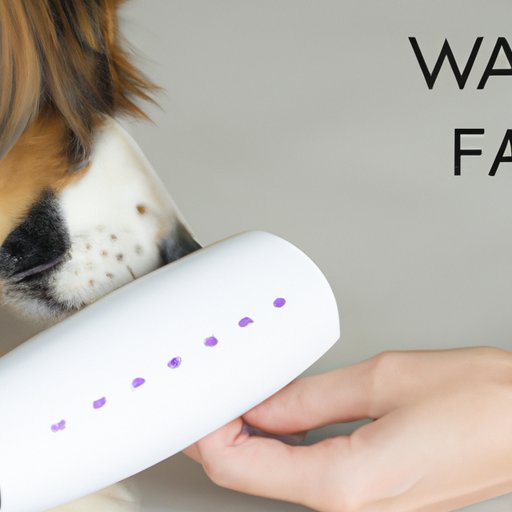
I. Introduction
As a dog owner, it’s important to be aware of the risks of flea infestations. Fleas are small insects that feed on your dog’s blood, causing irritation and potential health issues. One of the most common questions dog owners ask is whether they can see fleas on their furry friend. In this article, we’ll explore the truth about fleas, how to spot infestations, and provide tips for prevention.
II. The Truth About Fleas: Can You Actually See Them on Your Dog?
Fleas are tiny insects that measure between 1-4mm in length. They are reddish-brown in color and have a flattened body, which allows them to move quickly through an animal’s fur. While fleas can be visible to the naked eye, they are often difficult to spot due to their small size and ability to move quickly. Some fleas may also blend in with your dog’s fur, making them harder to see.
III. Spotting Fleas on Your Furry Friend: A Guide to Identifying Infestations
Spotting fleas on your dog can be challenging, especially if they have a thick coat. However, there are some signs that can indicate a flea infestation. These include:
- Excessive scratching or biting at the skin
- Red, irritated skin
- Small bumps or scabs on the skin
- Presence of flea dirt (black specks that resemble pepper) on your dog’s fur
Dogs who are allergic to flea bites may also develop a condition called flea allergy dermatitis, which can result in intense itching and skin irritation.
It’s important to detect flea infestations early on, as they can quickly multiply and spread throughout your home. Regularly grooming and checking your dog’s fur for signs of fleas can help with early detection.
IV. The Inconspicuous Enemy: How Fleas Hide on Dogs and What You Can Do About It
Fleas are experts at hiding on dogs, making them harder to spot. They often hide in areas with less hair, such as your dog’s groin, armpits, and ears. They may also hide in the carpet, bedding, or other areas where your dog spends time.
To effectively check for fleas on your dog, start by examining the areas where they are most likely to hide. Use a flea comb to groom your dog’s fur and check for signs of flea dirt or actual fleas. Be sure to dispose of any fleas or flea dirt in a garbage bag immediately after grooming.
V. Flea Hunting: Tips and Tricks for Finding these Pests on Your Canine Companion
Checking your dog for fleas can be a time-consuming process, but it’s an essential step in preventing infestations. Here are some tips for effectively finding fleas on your dog:
- Start at your dog’s head and work your way down their body, paying extra attention to areas with less hair
- Use a flea comb to groom your dog’s fur, stopping to inspect for fleas or flea dirt
- Run your hand over your dog’s fur to feel for bumps or scabs
- Be on the lookout for excessive scratching or licking
If you do find fleas on your dog, it’s important to act quickly to prevent the infestation from getting worse. There are many flea treatments available on the market, including topical treatments, flea collars, and oral medications.
VI. The Flea Factor: Understanding How These Tiny Insects Affect Your Dog’s Health
Fleas can cause a range of health issues for your dog, ranging from mild irritation to more serious conditions. Some of the health risks associated with flea infestations include:
- Excessive scratching or biting, which can lead to skin infections
- Transmission of diseases, such as tapeworms and typhus
- Flea allergy dermatitis, which can cause intense itching and skin irritation
Regularly checking your dog for fleas and using preventative measures can help mitigate the risks associated with flea infestations.
VII. A Closer Look at Fleas: Debunking Common Myths and Providing Valuable Detection Techniques
There are many myths surrounding fleas, which can make it difficult to know how to effectively detect and prevent infestations. Here are some common myths and detection techniques to set the record straight:
- Myth: Fleas only live on dogs
- Fact: Fleas can also live on cats, humans, and other mammals
- Myth: You can only get fleas if your dog goes outside
- Fact: Fleas can be brought into your home on clothing, shoes, and other items
- Myth: You can get rid of fleas by vacuuming your home
- Fact: While vacuuming can help remove flea larvae and eggs, it may not be enough to eliminate an infestation entirely
Effective flea detection techniques include regularly grooming your dog’s fur, checking for flea dirt, and using preventative measures, such as flea collars or topical treatments.
VIII. Conclusion
Flea infestations can be a nuisance for you and your furry friend. By understanding the truth about fleas, how to detect infestations, and preventative measures, you can ensure your dog stays healthy and flea-free. Remember to regularly groom your dog’s fur, check for signs of fleas, and use preventative treatments to keep these pesky insects at bay.





